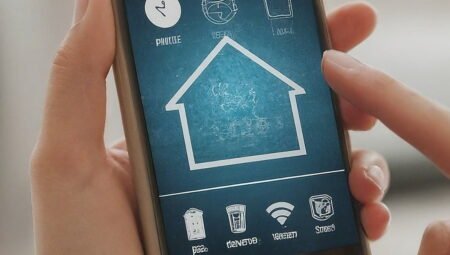
The Internet of Things (IoT) is changing our relationship with the world around us. By connecting everyday objects to the internet, IoT enables unprecedented levels of automation, data collection, and efficient decision-making. From smart homes and wearables to industrial applications and smart cities, IoT potential is vast and expanding. This article explores the Internet of Things in depth, discussing its benefits, applications, challenges, and future prospects. It also focuses on SEO optimization to reach a wider audience.
Understanding the Internet of Things
What is the Internet of Things?

It consists of a network of interconnected devices that exchange data over the internet. These devices, often embedded with sensors, software, and other technologies, collect and share information to perform specific tasks or provide valuable insights. IoT transforms ordinary objects into “smart” devices capable of interacting with each other and making autonomous decisions based on the data they gather.
How IoT works
IoT operates through hardware and software. Key components include:
- Sensors: Devices that collect data from the environment, such as temperature, humidity, or motion.
- Connectivity: Technologies like Wi-Fi, Bluetooth, and cellular networks that enable devices to communicate with each other and with central systems.
- Data Processing: Cloud platforms or edge computing systems that analyze sensor data.
- Actionable Insights: Applications or systems that use processed data to trigger actions or provide valuable insights for users.

Benefits of the Internet of Things
Enhancing Efficiency and Automation
IoT streamlines processes and automates tasks, leading to increased efficiency across various sectors. For example, smart home systems can automatically adjust lighting and heating based on occupancy, reducing energy consumption and improving comfort. Industrial IoT sensors monitor machinery in real-time, predicting maintenance needs and preventing costly downtime.
Improved data collection and analysis
IoT devices generate vast amounts of data, offering detailed insights into user behavior, environmental conditions, and system performance. This data enables businesses to make informed decisions, optimize operations, and tailor products and services to meet customer needs more effectively.

Greater convenience and personalization
IoT enhances convenience by enabling remote control and automation of devices. For instance, smart refrigerators can track inventory and suggest recipes based on available ingredients. Wearable fitness trackers provide personalized health recommendations based on activity levels and biometric data.
Advanced healthcare monitoring
In the healthcare sector, IoT devices play a crucial role in remote patient monitoring and personalized treatment. Wearable health monitors can track vital signs, alert healthcare providers to potential issues, and even enable telemedicine consultations, improving patient outcomes and reducing hospital visits.
Smart Cities and Sustainable Development
IoT contributes to smart cities by optimizing infrastructure and services. Public transportation efficiency can be improved by smart traffic management systems. IoT-enabled waste management systems can monitor waste levels and optimize collection routes, contributing to sustainability and cost savings.
Applications of the Internet of Things
Smart homes
Smart homes leverage IoT technology to enhance living environments. Key applications include:
- Home Automation: Control lighting, heating, and appliances remotely or via voice commands.
- Security Systems: Smart cameras, doorbells, and locks provide real-time monitoring and remote access.
- Energy Management: Smart thermostats and energy monitors optimize energy usage and reduce costs.
Wearable devices
Wearable technology, such as fitness trackers and smartwatches, utilizes IoT to monitor health and activity. These devices can:
- Track Physical Activity: Measure steps, heart rate, and calories burned.
- Monitor Health Metrics: Track sleep patterns, blood pressure, and other vital signs.
- Provide Notifications: Alert users to messages, calls, or reminders.

Industrial IoT (IIoT)
In industrial settings, IoT enhances productivity and safety. Key applications include:
- Predictive Maintenance: Sensors monitor equipment performance and predict maintenance needs.
- Supply Chain Management: IoT tracks inventory levels, shipments, and logistics in real-time.
- Process Optimization: Data analytics improve manufacturing processes and reduce waste.
Agriculture
IoT transforms agriculture by providing real-time insights into crop and soil conditions. Applications include:
- Precision Farming: Sensors monitor soil moisture, temperature, and nutrient levels to optimize irrigation and fertilization.
- Remote Monitoring: Drones and cameras provide aerial views of crops and livestock.
- Automated Equipment: IoT-enabled machinery performs tasks such as planting, harvesting, and fertilizing.
Smart cities
Smart city initiatives leverage IoT to enhance urban living. Examples include:
- Smart Traffic Management: Optimize traffic flow and reduce congestion using real-time data.
- Environmental Monitoring: Track air quality, noise levels, and weather conditions to improve public health.
- Public Services: IoT enhances services like street lighting, waste management, and parking.
Challenges of the Internet of Things
Security and privacy concerns
IoT devices often collect sensitive data, raising concerns about security and privacy. Vulnerabilities in IoT devices can be exploited by cybercriminals to access personal information, disrupt services, or launch attacks. Ensuring robust security measures and protecting user data is a critical challenge.
Data Management and Integration
The vast amount of data generated by IoT devices requires effective management and integration. Handling, storing, and analyzing this data poses challenges, particularly for organizations with limited resources or outdated infrastructure.

Interoperability and Standardization
IoT devices and platforms lack standardized protocols and interoperability, which hinders seamless integration. Establishing common standards and protocols is essential for compatibility and widespread adoption.
Power and Connectivity Issues
Many IoT devices rely on battery power or limited connectivity options. Ensuring reliable power sources and connectivity, especially in remote or underserved areas, is a significant challenge.
Scalability and Complexity
IoT devices become increasingly complex to manage and scale as the number of devices grows. Organizations must develop scalable solutions and manage multiple devices and platforms complexity. click here
Future of the Internet of Things
Advancements in AI and Machine Learning
The integration of AI and machine learning with IoT will enhance the capabilities of smart devices. Advanced algorithms will enable predictive analytics, autonomous decision-making, and improved personalization, driving innovation across various sectors.
Edge Computing
Edge computing, which involves processing data closer to the source, will play a crucial role in IoT’s future. By reducing latency and improving real-time data processing, edge computing will enhance IoT systems’ performance and reliability.
Enhanced Security Measures
The future of IoT will see the development of more robust security measures, including advanced encryption, AI-driven threat detection, and secure authentication protocols. These measures will address current vulnerabilities and protect against emerging threats.

Integration with 5G Technology
The rollout of 5G technology will significantly impact IoT by providing faster, more reliable connectivity. 5G will support the growing number of connected devices and enable real-time data transmission, enhancing the performance of smart applications and services.
Smart Environments and Human-Machine Interaction
The evolution of IoT will lead to more intelligent and responsive environments. Enhanced human-machine interaction, through natural language processing and intuitive interfaces, will make it easier for users to interact with and control smart devices.
Conclusion
The Internet of Things is transforming our world, offering new possibilities for automation, data analysis, and connectivity. From smart homes and wearable devices to industrial applications and smart cities, IoT is driving innovation and improving efficiency across various sectors. However, challenges related to security, data management, and interoperability must be addressed to fully realize the potential of IoT.
As IoT technology continues to evolve, advancements in AI, edge computing, and 5G will shape the future of connected devices and applications. By staying informed about these developments and implementing robust security measures, we can harness the benefits of IoT while mitigating risks and ensuring a secure, connected future.




